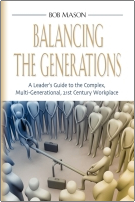 Get your copy now!
Get your copy now!
I'm proud to announce the release of my new book, Balancing the Generations: A Leader's Guide to the Complex, Multi-Generational, 21st Century Workplace
The book examines each generation, dispels common myths, and gives leaders tools to build a more effective organization by helping them recognize and take advantage of each generation's strengths.
If you were born between 1900 and 2000 and are in the 21st Century workplace, you need to read this book!
PLANNING TO EXCEL: STRATEGIC PLANNING THAT WORKS
 Get your copy now and Plan to Excel!
Get your copy now and Plan to Excel!
Plan for success
train your leaders to lead
and help them excel!!
With all the despair
about the economic situation,
this is the time
to plan and train
for a positive future.
Plan for success
and train your managers to lead! |

Leaders, Shift Workers, and Circadian Rhythm
By Bob Mason
Circadian rhythm. No it isn't a band. It's an approximately 24 hour cycle of activities your body accomplishes governed by what's often called your body's clock. For most people, their circadian rhythm is fairly constant; they usually eat and sleep at the same time, often in concert with the light and dark cycles of their environment.
But there's a group that's an exception: shift workers who regularly, or rather irregularly, change from one shift to another. For those people, there is no regular rhythm to their day. A study by Dr. Gloria J. Kuhn, published in the January, 2001 edition of Annals of Emergency Medicine, details problems experienced by emergency doctors who were on rotating shifts. She found that when workers did not receive sufficient sleep, they were more likely to have health issues, experience cognitive problems, and make mistakes. Her results indicated that night shift workers were more likely to experience circadian rhythm issues.
What does that have to do with me? Every leader who runs more than one shift needs to consider the effects of disruption to a worker's circadian rhythm. There's even a name for this: Shift Worker Disorder. Many companies have shift workers, but the biggest problem I've seen is in retail. That's because every retail store I've seen has convoluted and ever changing scheduling that can put workers through three different shifts in a single week.
But Dr. Kuhn's study was talking about doctors, right? True and we certainly want our doctors alert all the time, or at least when they're treating us. But think about what this can mean for your workers. Do they operate machinery such as forklifts and pallet trucks? Wouldn't you like to have them alert when they are operating equipment? Do they interact with customers? People who are chronically tired won't present as good an attitude.
Of course, if you have more than one shift, you must have workers to operate those shifts. What's a leader to do? Consider this. People are really adaptable creatures. If you assign someone to a midnight shift, they will adapt to those hours. It will take time, but adapt they will. It's the time required that is of interest to leaders. That adaption time can be several days. So, if you move a worker from one shift to another, they never get the time to adapt.
That's when problems will appear. As workers never get the opportunity to reset their own internal clock, they become less alert, more likely to have accidents, and more susceptible to health problems.
What's that costing you? Probably a lot more than smoothing out your shift scheduling.

Get a fresh new article every week to help you on your leadership journey.
Go to www.planleadexcel.com/Bobs-Blog

"Mad" Management
By Tim Bryce
One of the reasons AMC's "Mad Men" television show is so popular is that it tries to authentically depict American attitudes and moods of the early 1960?s, including how business was conducted. Viewers find it fascinating how the Mad Men think, the priorities driving them, and how they interact with employees and customers. Recently, I was going through some of my father's old papers back when he worked as Product Planning Manager at Remington Rand in New York City, the makers of the UNIVAC computer at the time. In particular, I came across a training manual entitled, "Creative Management Development" from 1961. Evidently it was used as part of a training class to groom managers for the company. Realizing this was from the same period and venue (corporate New York) as "Mad Men" I picked through the manual carefully to see the perspective of management back then. The manual was rather thick and consisted of several sections featuring different lessons. In particular, I came across a chapter entitled, "Elements of Effective Supervision" which included the following: "The most effective supervisor is the one who... 1. Delegates authority2. Makes definite assignments and supervises by results 3. Minimized detailed orders 4. Uses low pressure 5. Trains subordinates 6. Does different work from that done by his subordinates 7. Spends his time on long-range rather than short-range problems This is the pattern of what we call general supervision. As superiors intrude on matters that rightfully should be handled by their subordinates, problems have a tendency to snowball. One subordinate described the situation this way: 'As long as the boss gives us the right to make our own decisions, we cooperate with him. We report to him all the information he needs to answer to his boss, but the little things we don't bother him with. But if he doesn't give us any freedom we can make his life miserable. We can bombard his office with reports on everything we do. We can refuse to make a decision until we talk to him about it. We can stop saving his time by sifting the important from the unimportant and we can keep him on the run.'" Each of the seven sections were then explained in greater detail in the manual. The only problem I had between then and now was the distinction of supervisor versus manager. Whereas I tend to see a supervisor as someone working more closely with workers to assure work is performed properly, I tend to see a manager as more as a leader assessing priorities and plotting direction. Although the chapter referred to a "supervisor," I believe they were actually describing the duties of a "manager." For some rather old management advice from over a half century ago, I found it rather refreshing and interesting. It confirms what we've been saying for years, that managers need to learn to manage from the bottom-up, not just top-down. Employees should be properly trained, empowered, and allowed to assume responsibility. In other words, managers should manage more and supervise less, which is just the antithesis of today's micromanagement philosophy. The management advice from 1961 is every bit as applicable today as it was back then, making it something we should reconsider. Maybe one of the reasons viewers find the "Mad Men" program interesting is because it represents a time when we were more concerned with results as opposed to political correctness. And maybe we wish we could actively participate in such companies as the Sterling Cooper Advertising Agency where Don Draper is the charismatic creative director who knows how to make things happen. Maybe he attended the same training course with my father. Tim Bryce is a writer and management consultant located in Palm Harbor, Florida. http://www.timbryce.com// He can be contacted at: timb001@phmainstreet.com Copyright ? 2012 Tim Bryce. All rights reserved.
Article Source: http://EzineArticles.com/?expert=Tim_Bryce
http://EzineArticles.com/?Mad-Management&id=7004151
| |
Developing Leaders
We've talked about basic leadership training and training for mid-level leaders. The third part of a good leadership development program is development of senior and executive level leaders. These people operate at a different level than other leaders. They see a much bigger picture and have a much broader scope of responsiblity than leaders at any other level. Interestingly, even though they're the ones who set the leadership pace, they often don't have much face-to-face supervision responsiblity. These leaders combine high-level management with high-level leadership and their development program needs to address that.
The program at this level has a two-part approach. First, as leaders move to the senior and executive level, they need a much broader view of the company and the industry than was necessary before. Therefore, they need to be educated on all those aspects. If they have concentrated on sales, they need to learn about manufacturing, finance, legal issues, etc. The second part is sometimes difficult for leaders at this level to accept. It's simply that, if they haven't received the basic and mid-level leadership training, they need to start there. I've found that many senior leaders rose through the ranks without any formal leadership development. When their subordinate leaders start to learn the great techniques that will really transform the company, the senior leaders sometimes balk because they don't have that experience. They are more receptive if they've seen the training for themselves. |
A QUESTION ON LEADERSHIP
How can you write a strategic plan without a SWOT analysis?
I might ask that a different way. How can you develop a great strategic plan if you use a SWOT analysis as a limiting factor? An analysis of Strengths, Weaknesses, Opportunities, and Threats (SWOT)is probably a valuable tool when working on a marketing plan or finishing up your business plan. But it's a bad idea to include in a strategic plan. When I was first introduced to strategic planning over 20 years ago, SWOT wasn't even in the model. It, like other steps, has been added more recently. Here's why I think it's a bad idea.
First, the strategic plan should be a fundamental guide for your business success. In it you should identify the what,why, and how of your business. When leadership teams start to concentrate on the elements of a SWOT analysis, there is a strong tendency to start limiting possiblities. Remember that, ideally, you don't want to be responding to the market. You want the market to respond to you!
The other reason I don't use SWOT analysis in strategic planning is that I've found it tends to draw out, and often completely derail the planning process. Teams get too wrapped up in the analysis and tend to move to goal setting (if they ever get that far) to address issues from the analysis, and not the mission.
Please send your thoughts and questions to comments@planleadexcel.com.
|
| |
THINGS TO PONDER
Some Rules, Laws, Axioms, Observations,and Basic Assumptions.
Basic Assumption - For every action there is an equal and opposite criticism.
Law of Desire - The more you want it, the quicker the letdown after you get it.
Law of Genius - No boss will keep an employee who is right all the time.
Law of Management - Everyone you need is always someplace else.
Family Axiom - One child is not enough, but two children are far too many.
Rule of Searching - You can always find what you're not looking for.
| |
|
